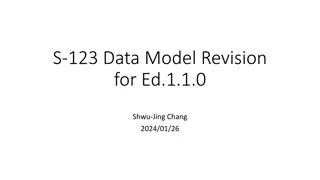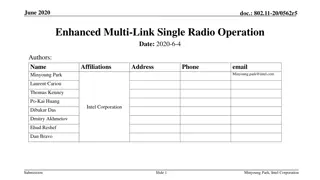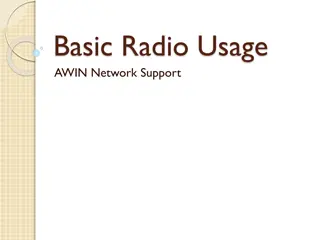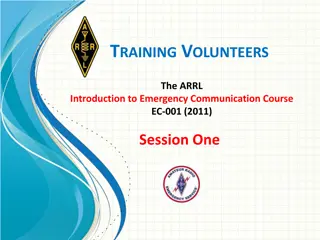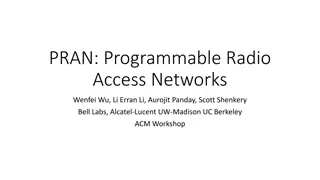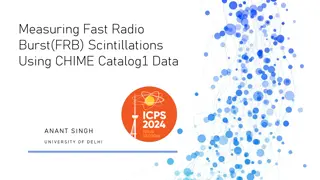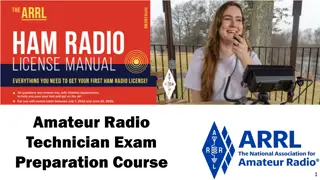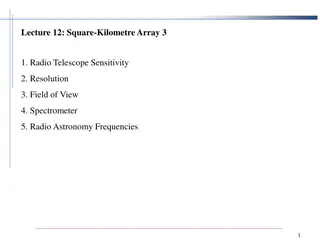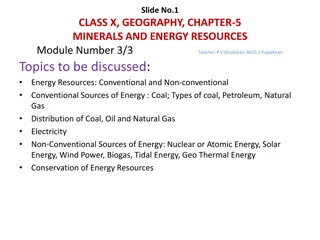Understanding Trunking vs Conventional Radio Systems in AWIN Network Support
Arkansas Wireless Information Network (AWIN) is a statewide digital trunked communications system utilizing APCO Project 25 standard. AWIN facilitates reliable communication for first responders with over 100 tower sites and 27,000 radios. Trunking enables efficient sharing of communication paths among multiple users, unlike conventional radio systems that use dedicated frequencies per channel. This overview delves into how trunking works, P25 technology, and the basic components of trunking radio systems.
Download Presentation

Please find below an Image/Link to download the presentation.
The content on the website is provided AS IS for your information and personal use only. It may not be sold, licensed, or shared on other websites without obtaining consent from the author. Download presentation by click this link. If you encounter any issues during the download, it is possible that the publisher has removed the file from their server.
E N D
Presentation Transcript
Conventional vs. Trunking Radio Systems AWIN NETWORK SUPPORT BASIC LEVEL OVERVIEW
Table of Contents What is Arkansas Wireless Information Network (AWIN)? Trunking Radio Systems Basic Overview Trunking vs. Conventional Radio Systems How Does Trunking Work? Trunking Simulcast Technology Digital vs. Analog Modulation Technology What is P25?
What is AWIN? The statewide, multiple site, digital 700/800 MHz trunked communications system using the Association of Public Safety Communications Officials (APCO) Project 25 (P25) standard. AWIN provides a reliable, statewide means of communication for the state s first responders. The AWIN system consists of over 100 tower sites and over 27,000 authorized radios. AWIN provides statewide operations, within the coverage area of the system for public service entities using P25 digital 700/800 MHz radios. AWIN is monitored 24/7/365 to ensure that it is available whenever the first responder needs it.
Trunking Radio Systems Basic Overview Zone Controller Site Controller Channel 2 Channel 1 Channel 3 Channel 4 Channel 5 Alt. Control Channel Control Channel
Trunking Radio Systems Basic Overview What is Trunking? Trunking is defined as: The sharing of a limited number of communication paths (or Trunks) among many users Trunking is not a term that is owned or belongs to a specific vendor/manufacturer. Trunking is not a term that is exclusive to radio systems.
Trunking vs. Conventional Radio Systems ? ? ? ? ?
Trunking vs. Conventional Radio Systems Conventional Radio (repeater) System: Uses a dedicated radio frequency for each radio channel in a system (unless sharing a channel) A Channel = a Frequency (i.e., 155.555 MHz is County Sheriff, 156.555 is County Fire) Each frequency is assigned to a group of users.
Trunking vs. Conventional Radio Systems Conventional Radio (base or repeater) System: A Channel = A Frequency If a channel is in use, the radio user must wait in queue before being able to transmit on the system. A new frequency must be obtained each time another channel is needed in the radio system. The system is limited by the number of frequencies in the system.
Trunking vs. Conventional Radio Systems Trunked Radio (repeater) System: Uses a group of similar radio frequencies to create a pool for radio system user to access. Systems can by built using VHF, UHF, 700, or 800 MHz. (AWIN is 700/800) A Channel is NOT a Frequency (generally speaking) A Channel(on your radio) is now a computer generated code referred to as a TALK GROUP
Trunking vs. Conventional Radio Systems Trunked Radio (repeater) System: The entire system is managed by a computer, on AWIN this is called the Zone Controller. One Zone Controller for the North of the State and one Zone Controller for the South of the State. All radio in the system, also, are computer controlled, and communicate to the Zone Controller via one frequency know as the Control Channel .
Trunking vs. Conventional Radio Systems Trunked Radio System Benefits: Greatly improved usage of radio frequencies (can be quite scarce depending on frequency band) Brings radio users together on a common radio system. Consistency in radio coverage. Greater over radio system flexibility, including: Channel (Talk Group) capabilities. Various user features, including Emergency Alarm, PTT ID, Channel Regrouping, Call Alert, and Radio Inhibit.
Trunking vs. Conventional Radio Systems Talk Group Dragging Dragging is when a talk group is being used across the radio system and is not part of the incident/area they are listening in to. A trunked (AWIN) radio system can not tell when a radio is just listening It assumes all affiliated radios are equally important and needs the recourses. This just listening will use up resources at each tower it crosses to get the message/PTT to you.
How Does Trunking Work? Control Channel continuously Transmits system data to all radios Channel 3 RX/TX Channel 2 Channel 4 Alt. Control Channel RX/TX Channel 5 RX/TX RX/TX Channel 1 Control Channel RX/TX Site Controller Zone Controller
How Does Trunking Work? Radio user presses TX button. The radio information is sent via the control channel To the site controller Channel 3 RX/TX Channel 2 Channel 4 Alt. Control Channel RX/TX Channel 5 RX/TX RX/TX Channel 1 Control Channel RX/TX Site Controller Zone Controller
How Does Trunking Work? The site controller processes the inbound request and sends the repeater channel command (in this case Channel 3) back to all radios selected on the same Talk Group Channel 3 RX/TX Channel 2 Channel 4 Alt. Control Channel RX/TX Channel 5 RX/TX RX/TX Channel 1 Control Channel Site Controller RX/TX Zone Controller
How Does Trunking Work? The original radio user s radio automatically switches to The correct voice channel and begins transmitting; All radios selected on the same Talk Group do the same and hear the voice transmission Channel 3 RX/TX Channel 2 Channel 4 Alt. Control Channel RX/TX Channel 5 RX/TX RX/TX Channel 1 Control Channel RX/TX Site Controller Zone Controller
How Does Trunking Work? Radio System Fleet Mapping: Radio Channels are now Called Talk Groups . Radio Zone 1 2 Dispatch 1 TG ID# XXXXXX TG ALIAS MAC CALL TG ID# XXXXXX TG ALIAS (Example Law Enforcement Shown Here) Dispatch 2 TG ID# XXXXXX TG ALIAS MAC 1 TG ID# XXXXXX TG ALIAS CID TG ID# XXXXXX TG ALIAS MAC 2 TG ID# XXXXXX TG ALIAS ADMIN TG ID# XXXXXX TG ALIAS MAC 3 TG ID# XXXXXX TG ALIAS
Trunking Simulcast Technology Simulcast Transmitting A radio system where the same radio frequencies are Simultaneously Broadcast from all tower sites within the radio system (That are grouped together). This allows the same radio frequencies to be used throughout the entire coverage area.
Trunking Simulcast Technology Simulcast Benefits Seamless communications throughout the radio system s coverage area Improved radio frequency utilization Improved coverage in areas with difficult terrain (includes tall buildings) Improved in-building coverage (signals in overlap zones are additive )
Trunking Simulcast Technology Simulcast Cons The technology can be expensive Tower site spacing in critical (especially when using NPSPAC frequencies) Signal timing is critical between all sites Tower site interconnection (via microwave, T1, etc.) is critical and can be expensive
Trunking Simulcast Technology Site 2 f1f2f3f4f5 Simulcast Site 5 Site 1 f1f2f3f4f5 Site 3 f1f2f3f4f5
Trunking Simulcast Technology Simulcast Issues Amplitude and frequency of transmitted signals must be very accurately timed to ensure good signal quality.
Trunking Simulcast Technology Simulcast Issues Slightly out of phase Ghosting on a T.V. set Out-of-phase signals can cause destructive cancellation. Fully in-phase signals produce constructive composite signals
Digital vs. Analog Modulation Technology Analog vs. Digital Digital is the newer format of the two Newer 700/800 MHz are digital What is the difference? Is digital better, and why?
Digital vs. Analog Modulation Technology Analog vs. Digital Information is sent by changing the frequency, amplitude, or phase of the radio signal. Analog Transmission Information is converted to true data bits and applied directly to the radio transmitter using FDMA (or TDMA or CDMA) Digital Transmission
Digital vs. Analog Modulation Technology Digital Benefits Clearer audio throughout system coverage area Improved radio frequency efficiency Improved system coverage Imbedded signaling options Encryption with little-to-no range loss
What is P25? P25 The standard for the manufacturing of interoperable digital 2-way wireless communications products. Also known as Project 25 or APCO 25. A user driven standard, it is not industry or Federal Government Standard
What is P25? P25 Equipment Must demonstrate compliance Meet the needs of public safety Be Interoperable with other P25 equipment



